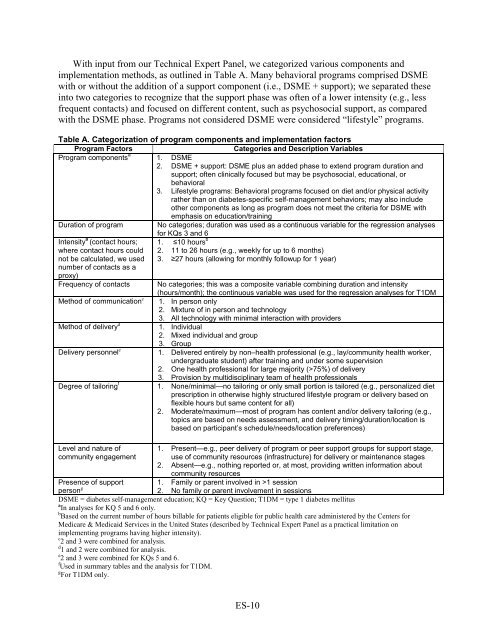Behavioral Programs for Diabetes Mellitus
diabetes-behavior-programs-report-150924
diabetes-behavior-programs-report-150924
- No tags were found...
You also want an ePaper? Increase the reach of your titles
YUMPU automatically turns print PDFs into web optimized ePapers that Google loves.
With input from our Technical Expert Panel, we categorized various components and<br />
implementation methods, as outlined in Table A. Many behavioral programs comprised DSME<br />
with or without the addition of a support component (i.e., DSME + support); we separated these<br />
into two categories to recognize that the support phase was often of a lower intensity (e.g., less<br />
frequent contacts) and focused on different content, such as psychosocial support, as compared<br />
with the DSME phase. <strong>Programs</strong> not considered DSME were considered “lifestyle” programs.<br />
Table A. Categorization of program components and implementation factors<br />
Program Factors<br />
Categories and Description Variables<br />
Program components a 1. DSME<br />
2. DSME + support: DSME plus an added phase to extend program duration and<br />
support; often clinically focused but may be psychosocial, educational, or<br />
behavioral<br />
3. Lifestyle programs: <strong>Behavioral</strong> programs focused on diet and/or physical activity<br />
rather than on diabetes-specific self-management behaviors; may also include<br />
other components as long as program does not meet the criteria <strong>for</strong> DSME with<br />
emphasis on education/training<br />
Duration of program No categories; duration was used as a continuous variable <strong>for</strong> the regression analyses<br />
<strong>for</strong> KQs 3 and 6<br />
Intensity a (contact hours; 1. ≤10 hours b<br />
where contact hours could 2. 11 to 26 hours (e.g., weekly <strong>for</strong> up to 6 months)<br />
not be calculated, we used 3. ≥27 hours (allowing <strong>for</strong> monthly followup <strong>for</strong> 1 year)<br />
number of contacts as a<br />
proxy)<br />
Frequency of contacts No categories; this was a composite variable combining duration and intensity<br />
(hours/month); the continuous variable was used <strong>for</strong> the regression analyses <strong>for</strong> T1DM<br />
Method of communication c 1. In person only<br />
2. Mixture of in person and technology<br />
3. All technology with minimal interaction with providers<br />
Method of delivery d<br />
1. Individual<br />
2. Mixed individual and group<br />
3. Group<br />
Delivery personnel e<br />
1. Delivered entirely by non–health professional (e.g., lay/community health worker,<br />
undergraduate student) after training and under some supervision<br />
2. One health professional <strong>for</strong> large majority (>75%) of delivery<br />
3. Provision by multidisciplinary team of health professionals<br />
Degree of tailoring f 1. None/minimal—no tailoring or only small portion is tailored (e.g., personalized diet<br />
prescription in otherwise highly structured lifestyle program or delivery based on<br />
flexible hours but same content <strong>for</strong> all)<br />
2. Moderate/maximum—most of program has content and/or delivery tailoring (e.g.,<br />
topics are based on needs assessment, and delivery timing/duration/location is<br />
based on participant’s schedule/needs/location preferences)<br />
Level and nature of<br />
community engagement<br />
1. Present—e.g., peer delivery of program or peer support groups <strong>for</strong> support stage,<br />
use of community resources (infrastructure) <strong>for</strong> delivery or maintenance stages<br />
2. Absent—e.g., nothing reported or, at most, providing written in<strong>for</strong>mation about<br />
community resources<br />
Presence of support 1. Family or parent involved in >1 session<br />
person g<br />
2. No family or parent involvement in sessions<br />
DSME = diabetes self-management education; KQ = Key Question; T1DM = type 1 diabetes mellitus<br />
a In analyses <strong>for</strong> KQ 5 and 6 only.<br />
b Based on the current number of hours billable <strong>for</strong> patients eligible <strong>for</strong> public health care administered by the Centers <strong>for</strong><br />
Medicare & Medicaid Services in the United States (described by Technical Expert Panel as a practical limitation on<br />
implementing programs having higher intensity).<br />
c 2 and 3 were combined <strong>for</strong> analysis.<br />
d 1 and 2 were combined <strong>for</strong> analysis.<br />
e 2 and 3 were combined <strong>for</strong> KQs 5 and 6.<br />
f Used in summary tables and the analysis <strong>for</strong> T1DM.<br />
g For T1DM only.<br />
ES-10


